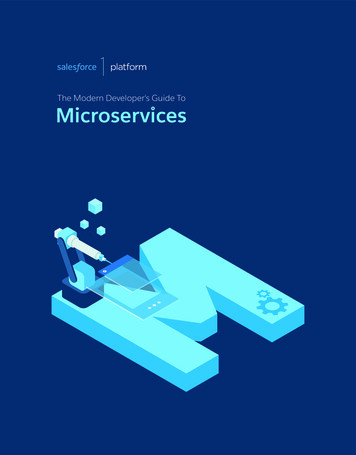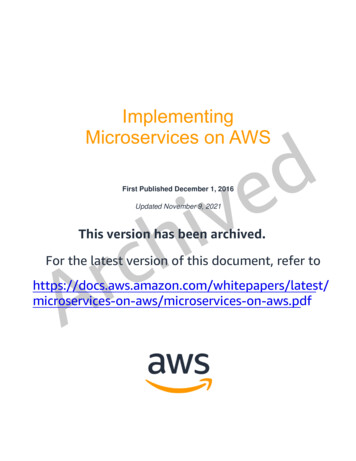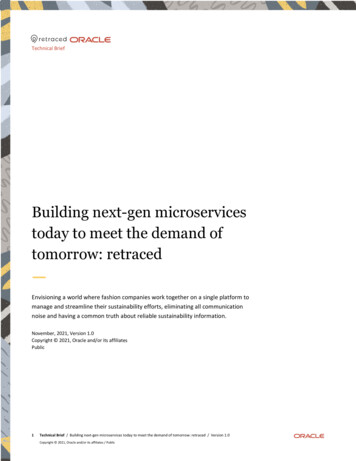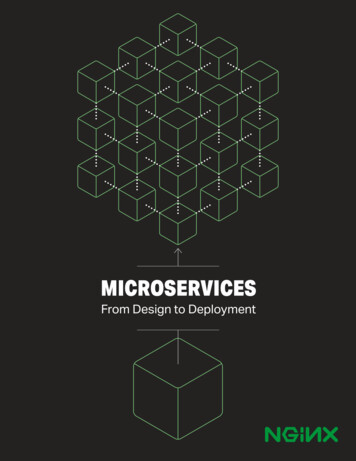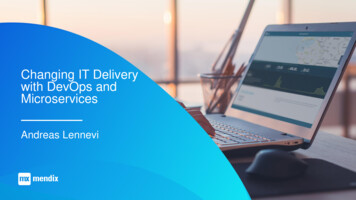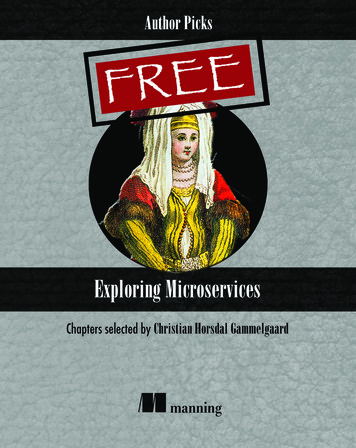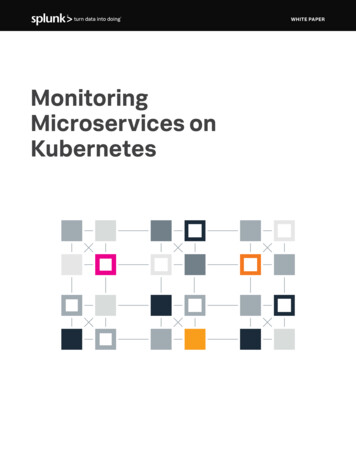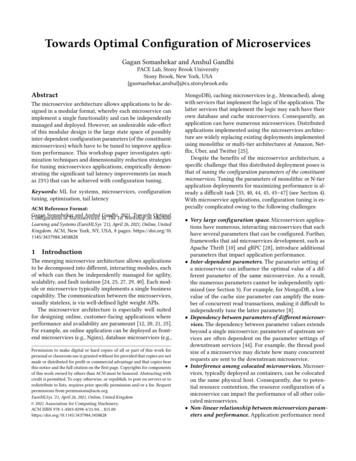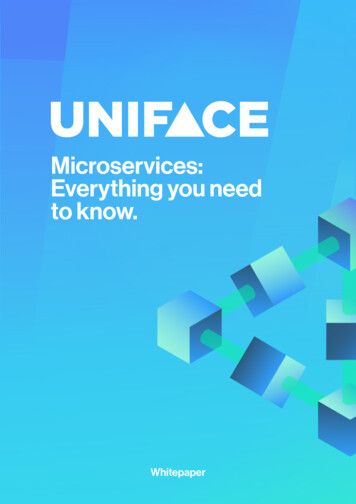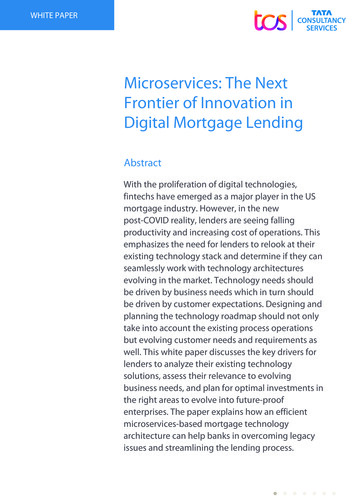
Transcription
WHITE PAPERMicroservices: The NextFrontier of Innovation inDigital Mortgage LendingAbstractWith the proliferation of digital technologies,fintechs have emerged as a major player in the USmortgage industry. However, in the newpost-COVID reality, lenders are seeing fallingproductivity and increasing cost of operations. Thisemphasizes the need for lenders to relook at theirexisting technology stack and determine if they canseamlessly work with technology architecturesevolving in the market. Technology needs shouldbe driven by business needs which in turn shouldbe driven by customer expectations. Designing andplanning the technology roadmap should not onlytake into account the existing process operationsbut evolving customer needs and requirements aswell. This white paper discusses the key drivers forlenders to analyze their existing technologysolutions, assess their relevance to evolvingbusiness needs, and plan for optimal investments inthe right areas to evolve into future-proofenterprises. The paper explains how an efficientmicroservices-based mortgage technologyarchitecture can help banks in overcoming legacyissues and streamlining the lending process.
WHITE PAPERTaking Stock of the Mortgage LandscapeThe mortgage industry works differently across the globe. For instance, inthe US, unlike other banking and financial technology solutions, mortgagetechnology solutions cannot be easily ported across geographies. Whilemortgage lending in most parts of the world is funded by bank depositsand is a banking activity, in the US, it is funded by mortgage backedsecurities and is therefore a capital market activity. In addition, aspects likemortgage insurance, consumer disclosure, regulatory compliance, andtypes of products vary significantly in the US. While most geographies havebroker and direct channels, the US has a unique variant in thecorrespondent channel. Most US lenders are non-bankers while those inother geographies are depository institutions. Moreover, most lendersacross the globe service their own loans while in the US, mortgage lenderseither sell the servicing rights or opt for substitute servicing. US lenderstherefore prefer to have multiple point solutions at every stage of mortgagelending such as origination, fulfilment, closing, and servicing. Consequently,most lenders spend millions on technology. In fact, according to a recentstudy, over the next five years, the global loan origination software marketwill expand at a compounded annual growth rate (CAGR) of 14.2%, to reachUSD 5,273.2 million by 2025.¹Most lenders typically use a core system for key functionalities of loanorigination and ancillary components for support functions. The traditionallending architecture (see Figure 1) has a complex legacy monolithic coreInterface ChannelsInternetMobileBranchIVRMulti-channel integrationLoanOriginationSystemSource of records - loan dataDocument managementBorrower data captureDocument uploadDisclosures mandated by regulationsRules managementDeliver document to customerVendor services order (credit, income, asset)Product master/eligibilityOther gUnderwritingClosingFundingPost closingCompliance checkReportsWorkflowPricingCore bankingand FundingsystemCustomerrelationshipmanagementVendor Services IntegrationAppraisersCredit BureausSolicitorsTitle CompaniesRegulatorsInusranceAgenciesFigure 1: Traditional Lending Architecture[1] MarketWatch, Industry News: Loan Origination Software Market share will grow at CAGR of 14.2 % says Marketstudyreport,Nov 2020, Accessed January 2021, -23?tesla y
WHITE PAPERsystem to support channels such as mobile, online, interactive voiceresponse (IVR), and other banking systems and integration gateways forvendor services such as appraisals and titles.In most financial institutions, the core loan origination system (LOS) is mostlikely a proprietary third-party or in-house solution with hundreds ofscreens, menus, tabs, and buttons as well as a user manual running intothousands of pages. This system that performs almost all the key functions isaccessible to every stakeholder, sales consultant, processor, underwriter,and closer, as well as users from support and quality control and otherfunctions. Loan application data is either entered or pulled into the LOSfrom a customer relationship management (CRM) system. Documents areeither stored in a separate enterprise content management solution orwithin the core solution. A traditional one-size-fits-all workflow moves thetask from one stage and/or stakeholder to the other, often requiringmultiple iterations.Such a traditional, monolithic LOS solution comes with several challengesincluding high dependence on the core system and potential single pointfailure, which is extremely risky. Moreover, most core systems are third-partysolutions, which are not open to customization and costly to maintain. Inaddition, the inability to customize inflexible legacy LOS prevents lendersfrom quickly implementing regulatory changes besides leading to scalabilityissues and hampering operational agility.In our experience, most loan origination systems are not able to keep upwith regulatory changes such as TILA RESPA Disclosure (TRID), UniformResidential Loan Application (URLA), Qualified Mortgage (QM) rules, andConsumer Finance Protection Bureau (CFPB) timelines. Almost all thesystems perform poorly in key areas such as status alert and closingcollaboration, in turn forcing lenders to switch to alternative options such ascreating more ancillary components.Modernizing Mortgage Lending with MicroservicesMicroservices facilitate the designing of solution architecture as a group orcollection of clearly defined services. By defining and creating uniquelyindependent services for each business function that can be easily clubbedtogether based on the need or demand, the entire architecture becomesloosely coupled, giving lenders the maximum flexibility for change.Each LOS functionality (see Figure 1) can be broken down into services suchas underwriting, closing, income, and asset service. They can then be ownedby specific teams and deployed independently and on demand. Theseservices should be self-contained so that their dependence on other servicesis minimal. For instance, income and asset services can be updated,
WHITE PAPERtechnologically or functionally, by independent teams, in parallel, therebyenhancing maintainability and testability.Presentation LayerConsumer PortalMobile/TabletBroker PortalServices LayerAdminstrationUser derwritingNotificationsAssetOther mentChatSolicitorContentManagementCore bankingand CharacterRecognitionLoand entVendor Management/Integration PortalAppraisersCredit BureausSolicitorsTitle CompaniesRegulatorsInusranceAgenciesFigure 2. Microservices-based Lending ArchitectureFigure 2 illustrates a representative reimagined lending architectureleveraging microservices. The microservices can be connected viaapplication programming interfaces (APIs) through one or more APIgateways. This ensures relevant protocol translation which in turn reducesdevelopment time and coding errors. This creates a well optimizedcommunication stream for faster data flow, reducing bandwidthrequirement and infrastructure cost.Benefits of a lending model leveraging microservices include:Replaceable components with less impact and dependence on othercomponentsHigher agility and resilience, enabling faster upgrades with lesserdowntimeHigher efficiency with reduced infrastructure costs and maintenanceFlexibility for organization-specific customization, enabling quickimplementation of regulatory change, higher scalability, andproductivityAbility to leverage open platformsHigher reusability across business lines as certain mortgage servicescan be used for credit cards, personal, auto loans, or even insurance
WHITE PAPERDecisioncategoryBusinessCostsRisksHowever, successful adoption of the microservices model will requirecareful execution to avoid implementation pitfalls. For example, if thedefinition and creation of services are not done accurately, the number ofmicroservices can become too large to be managed effectively. Highercyclic dependencies can go out of control and conflicts can arise ifservices are not clearly aligned with business functionalities. Similarly, ifthe API gateways are not appropriately defined or created, latency andcommunication issues can crop up. Security related aspects also need tobe taken into account while defining the architecture. Reimagining thelending architecture requires careful consideration of the possible slipupsthat could occur during the design phase, in the absence of which, theImportanceApplication 1Application 2Application 3Application 4microservices model can become more complicated than managinglegacy monolithic systems.53Chasing the Maximum3 Microservices allow lenders to get the maximum bang for their buck interms of operating expenses, so they can effectively fund their growthOperational2 and transformation initiatives. The biggest advantage is not just the cost,efficienciesbut the agility and resilience for faster upgrades with lesser downtime.Consolidated score Major banks across the globe have recently started exploringmicroservices in areas such as open banking and employment andincome verifications. The payments industry is also moving towardmicroservices. The mortgage industry can take a cue from thesecompanies to learn and adopt cross-industry best practices on gettingthe maximum out of the microservices technology.
WHITE PAPERAbout The AuthorRamani BalakrishnanRamani Balakrishnan is a senior businessconsultant in the Mortgage Practice of TCS’Banking, Financial Services, and Insurance(BFSI) business unit. He has over 30 years oftechnology and functional experience in theresidential mortgage industry. Ramani has ledlarge scale IT transformation programs forseveral TCS clients across the globe. He hasdesigned, developed, and implemented loanorigination and fulfillment systems. Ramaniholds an MBA in Finance (Summa Cum Laude)from Rutgers University, New Jersey, USA, anda Master’s degree in Physics fromBharathidasan University, Tiruchirapalli, India.ContactFor more information on TCS' Banking, Financial Services, and Insurance unit,please visit https://www.tcs.com/banking-financial-services or https://www.tcs.com/insuranceAbout Tata Consultancy Services Ltd (TCS)Tata Consultancy Services is an IT services, consulting and business solutions organization thatdelivers real results to global business, ensuring a level of certainty no other firm can match.TCS offers a consulting-led, integrated portfolio of IT and IT-enabled infrastructure, engineeringand assurance services. This is delivered through its unique Global Network Delivery ModelTM,recognized as the benchmark of excellence in software development. A part of the Tata Group,India’s largest industrial conglomerate, TCS has a global footprint and is listed on the NationalStock Exchange and Bombay Stock Exchange in India.For more information, visit us at www.tcs.comExperience certainty.IT ServicesBusiness SolutionsConsultingAll content / information present here is the exclusive property of Tata Consultancy Services Limited (TCS). The content / information contained here iscorrect at the time of publishing. No material from here may be copied, modified, reproduced, republished, uploaded, transmitted, posted or distributedin any form without prior written permission from TCS. Unauthorized use of the content / information appearing here may violate copyright, trademarkand other applicable laws, and could result in criminal or civil penalties. Copyright 2021 Tata Consultancy Services LimitedCorporate Marketing Design Services M 01 21Email: bfsi.marketing@tcs.com
microservices in areas such as open banking and employment and income verifications. The payments industry is also moving toward microservices. The mortgage industry can take a cue from these companies to learn and adopt cross-industry best practices on getting the maxi
